Affordable travel in the Czech Republic |
Outside Prague |
| • Kutná Hora |
| • Litomyšl |
| • Olomouc |
| • Český Krumlov |
| • Karlovy Vary |
| • Mělník |
| • Kutná Hora |
| • Karlštejn castle |
| • Terezín |
| • Lidice |
| • Adršpach Rocks |
| • Bohemian Paradise |
| • České Budějovice |
| • Český Ráj |
| • Hradec Králové |
| • Liberec |
| • Plzeň |
| • Telč |
| Mikulov |
| Ostrava |

All about Czech train tickets Every country has its own way of doing things, and this article is about what to expect when it comes time to organize your travels by train in the Czech Republic. The online timetables are the first place you should visit when planning your train travel. It’s the best way to find out what time trains run to your destination, how long they will take, and whether you have to change trains during your journey. What this tells us is that a train departs from Prague main station (hl.n stands for hlavní nádraží = main station) and reaches Kutná Hora 59 minutes later for a cost of 97Kč. If you're eligible for discount the cost would be 73Kč, but more on discounts below. At 11.10 there's a bus leaving from Prague's main 'Florenc' bus station, but it takes almost an hour and a half, so personally I wouldn't bother with that one. How much will it cost? The online timetables will give you more or less accurate prices for journeys within the Czech borders. For international tickets, however, it’s best to use jizdenka.cz. International tickets Standard International tickets look like this. This one’s an Olomouc-Krakow return. You may be able to see that it’s valid for two months and costs much less than two one-way tickets. (We’ll talk more about that under ‘discounts’). The '01 Erwachsener' at the top means one adult and the class of carriage is indicated in the 'Tř/cl/kl' box below. The price is self explanatory and the rest of it you don’t need to worry about too much. This is an ordinary domestic train ticket. Osob indicates the number of passengers, Třída is the class, and the group discount (see below) is indicated as Sleva pro skupiny. Jednoduchá means one way. If it was a return ticket, the word Zpateční would be printed instead. 231Kč each for 250km is pretty good value-cheaper even than the bus. Seat reservations Train tickets aren’t usually issued for a specific service. Notice that the tickets above have no train numbers or departure times printed on them. Domestic tickets are usually valid for any train on the day of purchase and the following day, and ordinary international tickets are valid for two months. If you really want a seat reservation, it’s usually enough to go in to the station a day or two before your journey and buy your ticket. If you’d like to plan even further ahead than that (maybe you’re travelling on the eve of a major public holiday?) you can even reserve online. The catch is that you need to then visit a Czech train station (it need not be the one you’re departing from) within a week, to pay for and pick up your seat reservation. Don’t forget to take along the printout with your reference number –it will look something like this:
Obviously visiting a Czech train station is not very convenient if you’re in, say, Chicago. Please believe me though that the trains are rarely full and it’s always enough to book, for example, your Friday ticket out of Plzeň when you arrive in town on the Wednesday. If you really want to be sure of tickets for particular train and you don't find it reassuring that everyone who knows says you'll be fine to buy your tickets once you get there, it is possible to buy them in advance online. The best way to go about it is to do a search on the timetables (see above), choose your train there and click on the small yellow icon with an 'R'. This will take you to the Czech rail online store and will prepopulate the form with the details of your train so that all you need to do is fill in the number of people, hit confirm, add to cart, and be ready with your credit card.
This is as far as I could go with purchasing a ticket from Usti nad Labem to Prague without actually putting my credit card details in: Discounts There are several ways to save money on Czech train tickets. The best are the 3-year 'In-Karta' (formerly Z-Karta) passes, which cost 600Kč. For the purposes of this article though, I’ll stick to those discounts that might be useful for short term visitors to the country. SONE+ tickets also allow up to 3 children (up to 15 years of age) to travel along with the two adults at no extra cost. The ticket is also valid for some towns in the border regions of neighbouring countries. Probably the most useful of those for international travellers are the services to Dresden in Germany and Cieszyn in Poland. At larger train stations domestic and international tickets are usually sold from different places. Vnitřostatní (Domestic) and Mezinárodní (International) are the words to look out for. You may find that the international tickets are sold from an office tucked away somewhere to the side of the station’s main hall. The same office might also issue travel passes and change foreign currency. For example, if want to catch the 10.44 express to get to Kutná Hora, the board will say 10.44 R707 HRADIŠŤAN Pardubice, Olomouc, Uherské Hradišťe, LUHAČOVICE. There will also be a number on the departures board under ‘Nást’, or nástupiště. That’s your platform. If there’s a number in the 'Zpoz' or zpozdění column, it means your train is delayed by that number of minutes. If you reserved a seat, you'll find it most easily if you get on the correct carriage. Either in the station or on the platform, there will be a sign showing the arrangement of carriages on the express and Intercity trains. Once on board, it's just a matter of walking along the carriage, checking for your numbered seat. If you haven't reserved a seat, be aware of the slips of paper in the numbered racks outside each cabin. They're reservations and that lovely empty windowside seat may not be available after all. Dogs, bicycle and guitars This article was originally published as a blog post, and people asked questions about travelling with dogs, bicycles, and other large pieces of luggage such as guitars: It's quite common for dogs and other pets to travel on trains in the Czech Republic. Small animals in a carry basket or cage travel free of charge. A supplemental fare of 15-30Kč applies for larger dogs. They must wear a muzzle, be on a leash and may not ride on the seats.
Fares for bicycles range from 25Kč for a short trip to 65Kč for a full day pass (please note it's a full day pass that expires at midnight on the day of use - it's not a 24 hour pass good until the same time the next day). People travelling with guitars and other large pieces of luggage usually just carry them on board and put them in the overhead racks that are in every carriage and compartment. The Pendolino train also have extra luggage storage at the enrtrance to each carriage. Please let me know if I've forgotten anything and enjoy your trip! |
• Home •Blog• About• Contact• Sitemap •Links•
Outside Prague last updated June 13th, 2010. All text and images Copyright 2007-2010. Articles may be excerpted for review, or printed for use by individual travellers.
Complete articles or images may not otherwise be reproduced by print, electronic or other means.
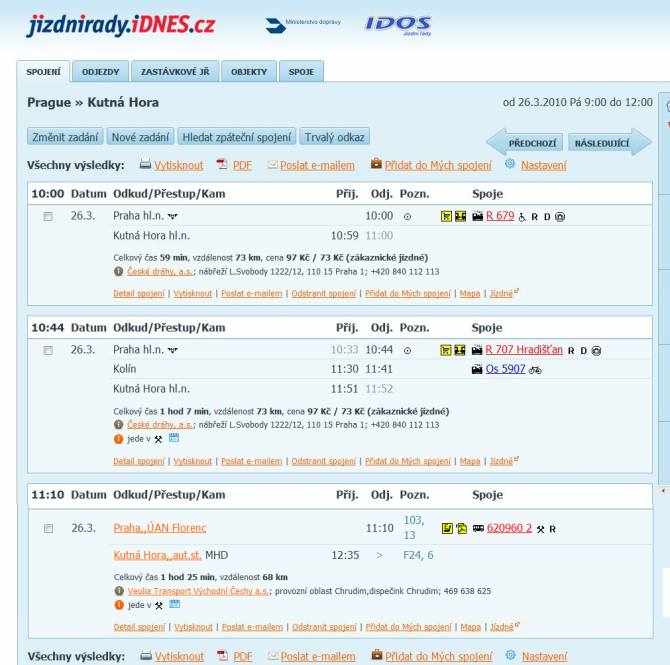

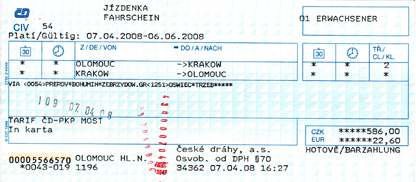
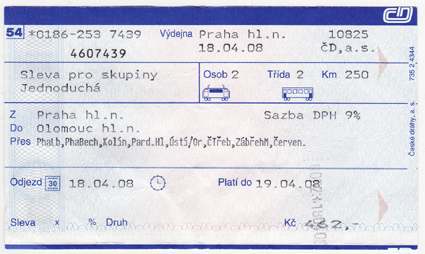
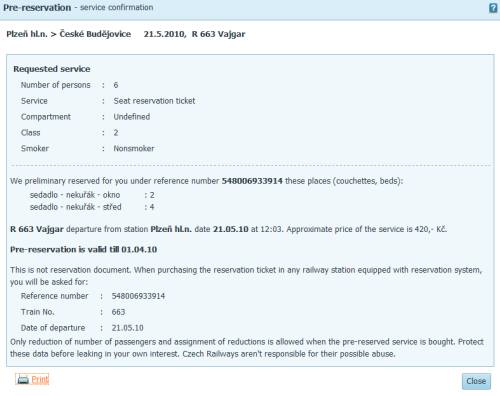
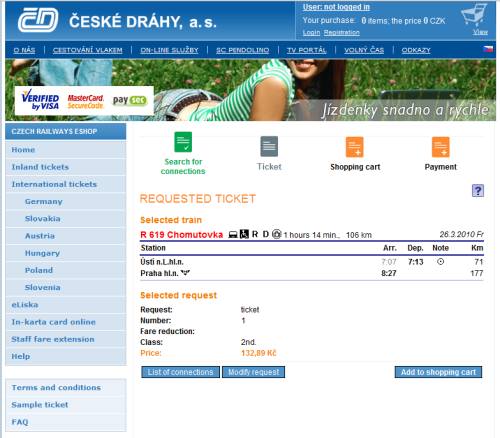 ]
] Bicycles can be transported on most trains, but the method varies depending on the particular service. The online timetables have symbols that indicate which trains have dedicated space for bicycles. A suitcase in a square means it's compulsory to reserve ahead because space is limited. A suitcase in an octagon shows that it's possible but not compulsory to reserve ahead, and a simple bicycle symbol shows that there is plenty of space and you can just show up and lift your own bike on board. Many EC and IC trains have no space at all for bicycles, but all the Superfast Pendolino trains do.
Bicycles can be transported on most trains, but the method varies depending on the particular service. The online timetables have symbols that indicate which trains have dedicated space for bicycles. A suitcase in a square means it's compulsory to reserve ahead because space is limited. A suitcase in an octagon shows that it's possible but not compulsory to reserve ahead, and a simple bicycle symbol shows that there is plenty of space and you can just show up and lift your own bike on board. Many EC and IC trains have no space at all for bicycles, but all the Superfast Pendolino trains do. 
